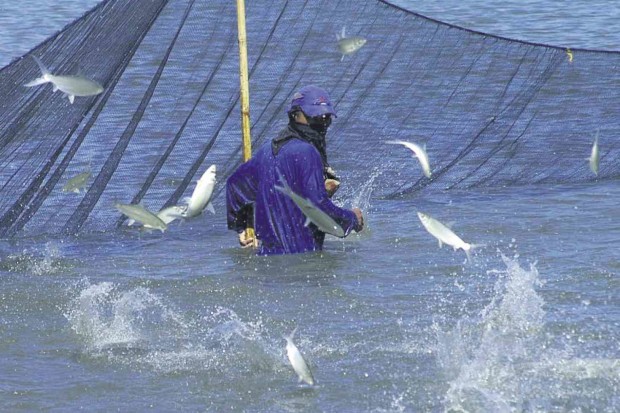Pangasinan braces for rise in ‘bangus’ demand with Laguna de Bay cleanup

FRESH HARVEST A fishpond worker prepares to harvest “bangus” (milkfish) in Dagupan City, a major source of the famous Bonuan variety that is sought by consumers. —WILLIE LOMIBAO
ANDA, PANGASINAN—As authorities dismantled hundreds of fish pens in Laguna de Bay last month, “bangus” (milkfish) growers in Pangasinan province released fingerlings into empty cages at Kakiputan Channel here to prepare for the expected high demand for the fish.
Laguna de Bay, which straddles the provinces of Rizal and Laguna and part of Metro Manila, produced 21,368.97 metric tons of bangus in 2015, according to the Philippine Statistics Authority’s (PSA) Fisheries Statistics of the Philippines.
This was about 5.56 percent of the annual bangus production of 384,425.49 MT that year.
“We can produce that [additional volume of bangus],” said Nominiza Garcia, president of FN Garcia Aquafarm here, one of the biggest bangus producers in Pangasinan.
Top bangus producer
Anda, Bolinao and Sual towns supply 80 percent of the province’s total annual bangus production. The brackish water ponds in Dagupan City and the coastal towns of San Fabian, Binmaley, Lingayen and Labrador produce the remaining 20 percent.
Their combined production had kept Pangasinan the country’s top bangus producer, contributing 106,857.37 MT, or 27.27 percent, to the country’s total production of 391,908.13 MT from 2013 to 2015, PSA data showed.
But Westly Rosario, head of National Integrated Fisheries Technology Development Center in Dagupan City, doubted that Pangasinan bangus growers could fill the production gap resulting from the demolition of pens at Laguna de Bay.
“We have a problem in western Pangasinan, which produces most of our bangus. The water quality there is no longer good,” Rosario said.
Fish kill episodes have been occurring since 2002 at Kakiputan Channel, where this town and Bolinao have established their mariculture zones. The area has been used for bangus culture since 1995.
Fish kills
“We did a core sampling there and we found that at the bottom of the channel was muck more than a meter thick. So we cannot deny that every year, fish kills take place there,” Rosario said.
According to him, water in the channel does not move during neap tides, reducing the dissolved oxygen (DO) level and sending the stocks to the surface belly up.
Sual, which has been aggressive in its bangus production, also has a problem with water quality, Rosario said.
The town’s mariculture area at Cabalitian Bay, which hosts 800 cages, has almost zero DO in its sea bed, he added.
Aside from the deteriorating water quality in the mariculture zones, Pangasinan’s bangus growers are having difficulty in buying bangus fry, Rosario said.
He cited a study of the University of the Philippines Marine Science Institute that said the country needed at least 1.5 billion bangus fry every year.
“We could not produce this number. Nobody knows how many fry we are importing. I think there’s a problem in counting,” he said.
Indonesian imports
Isagani Rarang, also a bangus grower here, said he and the other farmers imported millions of fry from Indonesia.
“The problem with imported fry is that only about 10 percent are alive when they arrive here,” he said.
According to Rosario, it usually takes 10 to 15 days for the fry to recover from stress they suffered while being transported.
Once they reach farms here, the fry are first reared in transition ponds for 60 days until they become 3- to 4-inch fingerlings. The fingerlings are then released in cages. They are harvested after four to six months.
A hatchery in Sual would have been a good source of fry but it could not meet the requirement of 2 to 3 million fry, Rarang said, adding that the hatchery could provide only 500,000.
To make sure that there are enough bangus when a major fish kill breaks out in western Pangasinan, the government should start looking for other areas outside the province that could be developed into mariculture zones, Rosario said.
“We have no expansion areas in Pangasinan. We could no longer produce more because our mariculture areas have limits,” he said.
“We have already banned pens and cages from our rivers. In Dasol [town], they do not like [aquaculture] there because it will destroy their salt industry. They won’t also like it in Alaminos [City] because it will destroy their tourism,” he added.
Alaminos hosts the Hundred Islands National Park.
Bangus industry dev’t
A good place to start bangus culture would be at Casiguran Sound in Aurora province, Rosario said. “It was declared as a mariculture park seven years ago and it’s easier to manage than western Pangasinan,” he said.
With good roads and an airport there, it would be easier to transport bangus to Metro Manila and other regions, he said.
To address the country’s bangus fry shortage, Rosario had proposed a bangus fry industry development program, which, he said, had been approved by Agriculture Secretary Emmanuel Piñol and Director Eduardo Gongona of the Bureau of Fisheries and Aquatic Resources.
Under the program, government facilities will produce bangus eggs which will be sold to private satellite hatcheries. “This is the Indonesian model, which is already tested. We don’t have to reinvent the wheel,” Rosario said.
He said: “Local government officials are still in denial that their mariculture areas are deteriorating. Maybe because these are revenue earners in their place. But if science comes in, the water there is no longer healthy.”
Improving the water quality in mariculture zones should take precedence for the survival of Pangasinan’s bangus industry, Rosario said.
“We just have to focus. A better water quality means maximum profitability of the venture,” he said.














